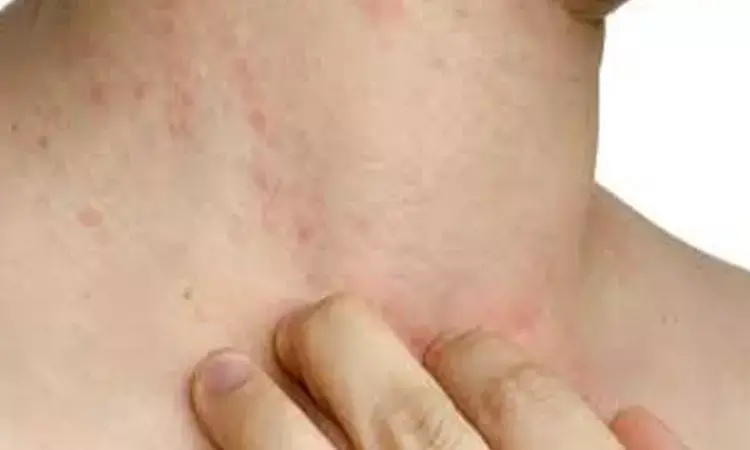- Home
- Medical news & Guidelines
- Anesthesiology
- Cardiology and CTVS
- Critical Care
- Dentistry
- Dermatology
- Diabetes and Endocrinology
- ENT
- Gastroenterology
- Medicine
- Nephrology
- Neurology
- Obstretics-Gynaecology
- Oncology
- Ophthalmology
- Orthopaedics
- Pediatrics-Neonatology
- Psychiatry
- Pulmonology
- Radiology
- Surgery
- Urology
- Laboratory Medicine
- Diet
- Nursing
- Paramedical
- Physiotherapy
- Health news
- Fact Check
- Bone Health Fact Check
- Brain Health Fact Check
- Cancer Related Fact Check
- Child Care Fact Check
- Dental and oral health fact check
- Diabetes and metabolic health fact check
- Diet and Nutrition Fact Check
- Eye and ENT Care Fact Check
- Fitness fact check
- Gut health fact check
- Heart health fact check
- Kidney health fact check
- Medical education fact check
- Men's health fact check
- Respiratory fact check
- Skin and hair care fact check
- Vaccine and Immunization fact check
- Women's health fact check
- AYUSH
- State News
- Andaman and Nicobar Islands
- Andhra Pradesh
- Arunachal Pradesh
- Assam
- Bihar
- Chandigarh
- Chattisgarh
- Dadra and Nagar Haveli
- Daman and Diu
- Delhi
- Goa
- Gujarat
- Haryana
- Himachal Pradesh
- Jammu & Kashmir
- Jharkhand
- Karnataka
- Kerala
- Ladakh
- Lakshadweep
- Madhya Pradesh
- Maharashtra
- Manipur
- Meghalaya
- Mizoram
- Nagaland
- Odisha
- Puducherry
- Punjab
- Rajasthan
- Sikkim
- Tamil Nadu
- Telangana
- Tripura
- Uttar Pradesh
- Uttrakhand
- West Bengal
- Medical Education
- Industry
Chronic inflammatory skin diseases not linked to VTE risk, finds JAMA study

In a recent large-scale cohort study, chronic inflammatory skin diseases (CISDs) were not associated with an increased incidence of venous thromboembolism, after controlling for relevant VTE risk factors in a representative dermatology patient population. The interesting results have been put forth in JAMA Dermatology.
Several studies have linked (CISDs) with venous thromboembolism (VTE) in a range of data sources with mixed conclusions. To examine the incidence of VTE in patients with vs without CISD, a team of researchers from Division of Pharmacoepidemiology and Pharmacoeconomics, Department of Medicine, Brigham and Women's Hospital, Massachusetts ,undertook the current study .
For the study design, a cohort study using commercial insurance claims data from a nationwide US health care database from January 1, 2004, through 2019 was conducted. A total of 158 123 patients with dermatologist-recorded psoriasis, atopic dermatitis, alopecia areata, vitiligo, or hidradenitis suppurativa were included. Risk-set sampling identified patients without a CISD. Patient follow-up lasted until the first of the following occurred: VTE, death, disenrollment, or end of data stream.
Venous thromboembolism events were identified with validated algorithms as the main outcomes. Incidence rates were computed before and after 1:1 propensity-score matching to account for VTE risk factors. Hazard ratios were estimated to compare the incidence of VTE in the CISD vs non-CISD cohorts.
Results highlighted some key facts.
- A total of 158 123 patients were identified with CISD: with psoriasis (n = 96 138), atopic dermatitis (n = 30 418), alopecia areata (n = 17 889), vitiligo (n = 7735), or HS (n = 5934); 9 patients had 2 of these conditions. A total of 1 570 387 patients were without a CISD.
- The median follow-up time was 1.9 years (interquartile range, 0.8-4.0 years) in patients with CISD.
- The incidence rate (per 1000 person-years) of outpatient or inpatient VTE was 1.57 in psoriasis, 1.83 in atopic dermatitis, 0.94 in alopecia areata, 0.93 in vitiligo, 1.65 in HS and 1.53 in CISD overall, compared with 1.76 in patients without a CISD.
- Incidence rates increased in patients aged 50 years or older (2.3 per 1000 person-years) and decreased in those aged 18 to 49 years (0.8 per 1000 person-years).
- After propensity-score matching to patients without a CISD, the hazard ratio (HR) of VTE was 0.86 (95% CI, 0.75-0.99) in psoriasis, 1.19 (95% CI, 0.95-1.48) in atopic dermatitis, 0.97 (95% CI, 0.65-1.46) in alopecia areata, 0.90 (95% CI, 0.49-1.65) in vitiligo, 1.64 (95% CI, 0.82-3.27) in hidradenitis suppurativa, and 0.94 (95% CI, 0.84-1.05) in CISD overall.
"In this newer era of advanced systemic medications for treatment of chronic inflammatory skin diseases, having a background rate of venous thromboembolism established may help monitor the safety of newly marketed systemic treatments in dermatology."the team concluded.
For full article follow the link: doi:10.1001/jamadermatol.2021.1570
Source: JAMA Dermatology
Dr Satabdi Saha (BDS, MDS) is a practicing pediatric dentist with a keen interest in new medical researches and updates. She has completed her BDS from North Bengal Dental College ,Darjeeling. Then she went on to secure an ALL INDIA NEET PG rank and completed her MDS from the first dental college in the country – Dr R. Ahmed Dental College and Hospital. She is currently attached to The Marwari Relief Society Hospital as a consultant along with private practice of 2 years. She has published scientific papers in national and international journals. Her strong passion of sharing knowledge with the medical fraternity has motivated her to be a part of Medical Dialogues.
Dr Kamal Kant Kohli-MBBS, DTCD- a chest specialist with more than 30 years of practice and a flair for writing clinical articles, Dr Kamal Kant Kohli joined Medical Dialogues as a Chief Editor of Medical News. Besides writing articles, as an editor, he proofreads and verifies all the medical content published on Medical Dialogues including those coming from journals, studies,medical conferences,guidelines etc. Email: drkohli@medicaldialogues.in. Contact no. 011-43720751


